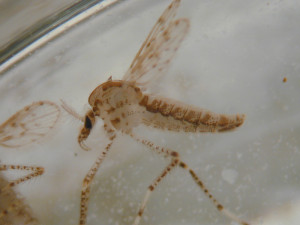After the past few weeks of cold weather, it’s natural to day dream a little about the warm, pleasant days of late spring and summer. At least that’s how we think of them when it’s cold enough to freeze a catfish. We want to remember cool lemonades in the shade, evening baseball games and fireworks. We tend to forget the 100 degree days, weeds and lawns that won’t stop growing, chiggers, mosquitoes and midges. Well, if you’re lucky enough to live next to a lake or pond, you might remember the midges.
Midges are one of those tiny aquatic flies that emerge sporadically in large numbers from streams, ponds and lakes. They look a little like miniature mosquitoes, though they don’t bite. They do, however, fly in your mouth, hover around the porch lights and (if you were my caller today) turn your patio and porch black with millions of tiny midge bodies. Most midges associated with lakes and ponds belong to the fly family Chironomidae (KY row NOME id dee). This particular call came from a person who lives on a golf course, the homes of which each summer are inundated with millions of midges. The presumed source is a small pond on the course, and she wanted to know what their neighborhood association could do to get ahead of next year’s hoardes.
Not all ponds turn into midge factories. Midges are more likely to emerge in large numbers from ponds that receive a lot of fertility in incoming water and runoff. I can’t say for sure, but I suspect that in this case the course may be applying fertilizer too close to the lake, just before heavy rain events, or over-applying it to turf around the lake. So part of the solution to my caller’s complaint about summertime midges is probably talking to the golf course about their fertility program and ways to reduce fertilizer runoff into the pond.
Elmer Gray, entomologist with the University of Georgia enlightened me today on some other ways to get relief from excessive midge production from small ponds (not going to work on larger lakes). He and colleagues recently completed a study where they looked at use of a bacterial insecticide containing Bacillus thuringiensis israelensis (Bti). This particular microbe makes a useful insecticide used to kill mosquitoes and blackflies. Turns out that it can do a pretty good job on non-biting midges as well.
Gray and colleagues noted that killing the larvae before they emerge from their breeding source is the most effective approach, though it can be difficult and expensive. For their study they used a formulation of Bti known as Bactimos PT. This is a granulated pellet formulation that sinks to the bottom of the pond after application. It can be dispersed most effectively with a gasoline-powered, mist/duster backpack applicator. They reported an average of 95% reduction of larval populations the first week of the study in the two years of trials. After two weeks they still averaged 70% reduction, and by the third week they averaged 50% reduction of midge larvae over pre-treatment numbers. By the fourth week, larval populations had returned to normal, showing the need for repeated applications as well as the short term ecological impact of this relatively safe biological insecticide.
Interestingly, they were able to get the same level of control in relatively small ponds whether they treated the entire pond surface, or just the 20 or so feet around the pond shoreline. In their South Carolina test plots they concluded that most midge breeding occurred along the shoreline.
These results don’t guarantee equal success for all midgy ponds, as some types of midge are less affected by Bti than others, and breeding conditions may be somewhat different in Texas vs. South Carolina. Also, such treatments should be considered temporary suppression and not control. Nevertheless, many homeowners who suffer from midge invasions at least have an option to get relief from midges in smaller water bodies. The Bti bacteria used in this study, by the way, are considered highly selective and safe for fish, pets and swimming in treated water, according to label directions.
Gray also noted that for ponds that do not have a running spillway, another option is the use of Agnique® monomolecular film. This is a synthetic polymer film that floats on the surface of the pond and disrupts the midge’s ability to emerge from the water or lay eggs successfully. If the pond does not drain via a spillway, the film can remain on the surface for up to 21 days. If using the film, Gray recommends re-treatment every three weeks for two months at the beginning of the season, and at the end of the summer, during the periods when you notice the heaviest midge emergence.
A final note. You’re unlikely to find either Bactimos or AgNique products at your local farm store. You may have to hire a pest management professional to purchase and apply these products.
As we shiver through these next few weeks of the waning Texas winter, take a few minutes to recall the better parts of the long summer months. Here’s to a less midgy summer this year.
